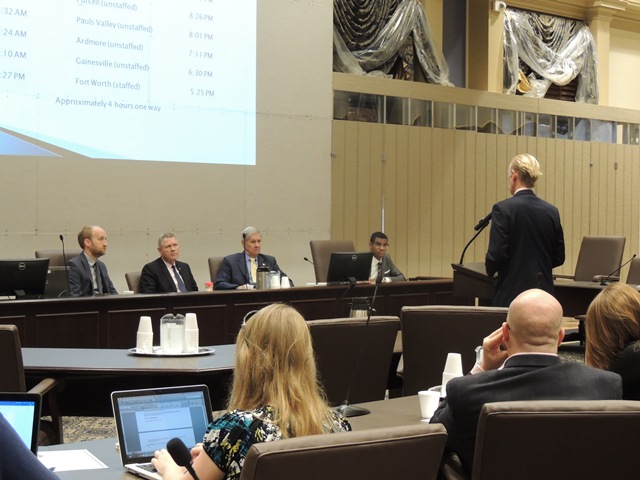Senate examines costs/benefits of the Heartland Flyer
 The Senate Transportation Committee hears presentations about the Heartland Flyer.
The Senate Transportation Committee hears presentations about the Heartland Flyer.
The Senate Transportation Committee held an interim study Wednesday to look at the both the costs and the benefits of the Heartland Flyer, the AmTrack line that brought back passenger rail service between Oklahoma City and Fort Worth after a 20 year absence.
Sen. Frank Simpson, R-Springer, requested the study. His district includes Ardmore, one of the stops on the Heartland Flyer line. That community and Oklahoma City are both making millions of dollars in infrastructure investments in their railway stations and other related improvements to capitalize on the rail line.
“I have several concerns I wanted us to look at. Texas and Oklahoma used to each pay the same amount in state contributions—it was a 50/50 split. Now it’s closer to 60/40, with Oklahoma paying more, but Texas receiving more of the economic benefits,” Simpson said. “The daily schedule really favors Texas—it’s more convenient for riders traveling south than it is for those coming north. I’m also concerned that the contract only runs a year at a time. I think when we have cities in Oklahoma making major investments a longer term contract would be tremendously helpful.”
Among those addressing the committee Wednesday were Mike Patterson, Executive Director of the Department of Transportation; Roy Williams, President of the Oklahoma City Chamber of Commerce; representatives of the city of Ardmore; Neal McCaleb, Ambassador At-Large of the Chickasaw Nation; and Tod Stennis, AmTrack Government Affairs Director, South.
Williams said the rail line was vital to current and future economic development efforts. He told the committee that when Oklahoma City looked at peer cities like Denver and Salt Lake City, they were expanding passenger rail service, and said the Heartland Flyer was critical to doing that here. He said it was important not to think of passenger rail as just an issue involving Oklahoma and Texas.
“It’s really a means of aligning and linking cities all the way from Chicago to almost Mexico,” Williams said. “Eventually we could have a Chicago, St. Louis, Kansas City, Oklahoma City, Fort Worth system here. When you think really long range, these are huge opportunities for our city.”
Committee members were also told that initial research had shown continuing the Heartland Flyer to Newton Kansas would more than double ridership, and connect Oklahomans to additional destinations via passenger rail.
Simpson said he still had more questions after the hearing, and wanted to see the state move to a longer-term contract with Texas with a schedule that was more advantageous for Oklahoma.
“Oklahoma City is investing close to $30 million. My small community of Ardmore is going to make an investment of almost $2 million. I want to make sure they have a sense of security in doing that. That would come with a long-term contract, five or ten years out,” Simpson said. “The long-term agreement question was not answered, but that’s something I’ve got to pursue with ODOT and probably with Texas.”
He said he was very encouraged about the potential for new ridership if the Heartland Flyer is expanded north to Kansas, although he thought the projections that it would draw more than twice the passengers might be overly optimistic. He also was encouraged by what McCaleb had to say about the proposed Heartland Flyer stop in Thackerville, with the Chickasaw Nation’s WinStar World Casino and Resort, and how it would help bring even more Texans to spend money in Oklahoma.
“Based on what I heard today, I think it’s a worthwhile investment. I want some good information on the economic impact—how is that money being spent, how do we know that money is being spent and what is the metric we measure that by? I probably have questions coming out of this but I think I have a better idea of the questions I need to ask,” Simpson said.
 Oklahoma Senate
Oklahoma Senate

